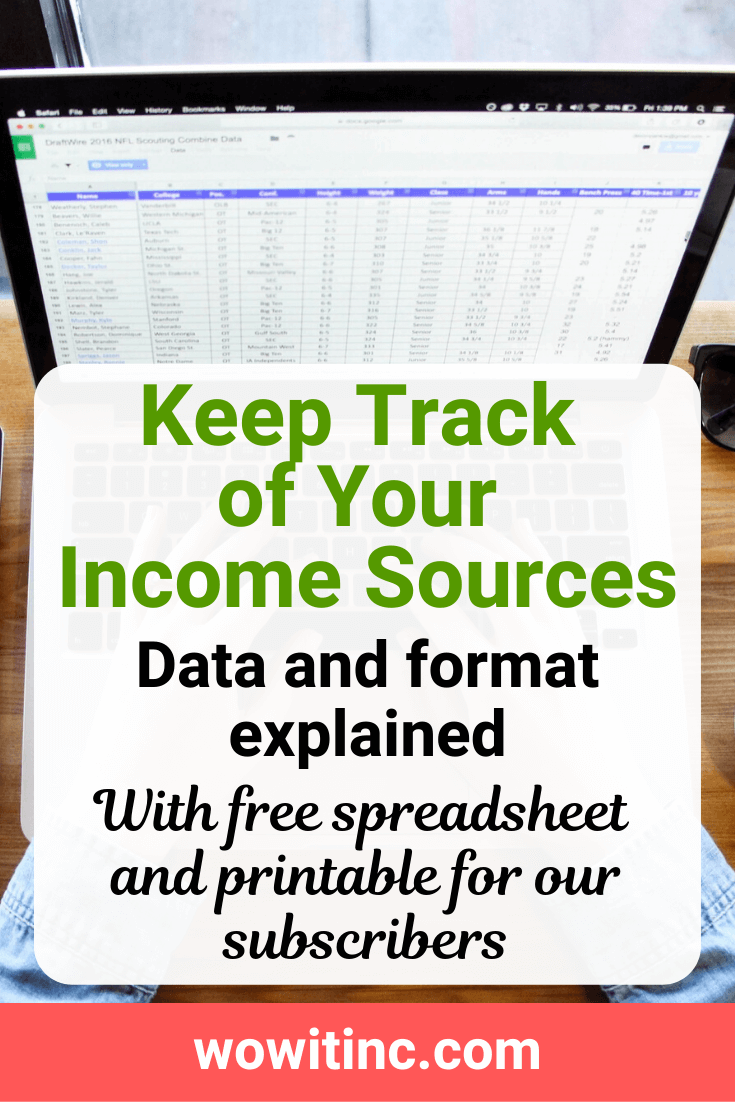How do you track your income? If you are employed full-time by a separate company then you probably just wait for your income slips to arrive. Then you confirm your pay was deposited in your bank account and maybe update your budget.
But what if you earn some extra income through side hustles. How do you track that income?
Perhaps your other thought right now is why do I need to track that income?
Why you should track your income
Understanding where your money comes from is critical to your financial success. If you don’t have clear information on the source of that income then it’s almost impossible to plan your future finances. What to consider?
Taxation
This may not be a popular reason but it’s necessary. You need to track your earnings so you know exactly how much you’ll be taxed. This way you can ensure the amount is correct.
If you’re receiving income from side hustles then you also want to ensure you stay within certain tax brackets. Tracking your earnings across all your income sources gives you the opportunity to decline work if you’re approaching any thresholds.
Evaluate sources
When you have multiple sources of income, how do you know which sources are best? You need to track your income so you can focus your energies on the sources that are working best for you. You want to consider two factors:
- Highest income
- Overall – you’ll want to know exactly which source has paid you the most so far
- Per gig – you also want to see which source is paying you better for each engagement or gig
- Most opportunities – another factor is consistency. You need to be able to see which source is presenting you with the most options.
Evaluating your sources will help you make decisions about where to focus your efforts.
How you can track your income
Now that you understand why tracking your income is important, let’s focus on the how.
If you have an accountant, then you’re probably not reading this article. But, for most of us, we have to manage our finances ourselves.
Now, you could consider using accounting software such as QuickBooks or FreshBooks for example. But that means spending some money.
Otherwise, the most logical, and the easiest (outside of accounting software), way to track your income is through a spreadsheet. You have a lot of options: Microsoft Excel, Google Sheets, Apple iWork Numbers, etc. Some of these options cost money but some of them are available for free.
Tracking Setup
If the thought of setting up your own spreadsheet makes you gnash your teeth or shrink with anxiety, fear not. You can simply grab my free “Gig Tracker” spreadsheet.
If you’re comfortable with spreadsheets then keep reading for information to create your own.
So let’s break down the format and the information you need.
Sources
You need to define every potential source of income for your tracking. You might restrict these to just your side hustles outside of your regular full-time job. Or you might include your “day job” too. But the focus here is primarily on side hustles, supplementary income.
Regardless, you need a way to identify the sources clearly. If possible, you also want a method to ensure you only need to type that source once and then just reference it whenever you need it. This way you don’t run the risk of any spelling errors giving you misinformation later on.
Data entry
The core of your information will be entering data related to your sources. You’ll need to be able to associate your income with your source. But there are a number of other considerations too:
- Published pay/rate – each gig or activity will have a price or rate identified. This is the base rate you expect to receive if you complete the work correctly and on time. But you also need to be aware of any deductions or bonuses.
- Deductions – if your work is not satisfactory or it’s late, then you might receive only partial pay
- Bonuses – if you completed the gig within a rush deadline, as an example, then you might receive a bonus for your efforts
So you also need a method to track the variations in the published pay or rate.
- Expenses – some work might reimburse you for different types of expenses. You need to track, at a minimum, the amount of the expense so you can ensure you’re reimbursed appropriately. You’ll also want to consider whether the particular type of expense is important for you to track.
- Pay schedule – different sources will have different schedules for their payments. For example, some might pay immediately upon the work being completed. Others might pay only after a “clearing” period has passed. And still others might have a standard weekly or monthly payment schedule.
Data overview
Let’s say you have your data entry sorted out and you’ve even entered some information. Previously, I mentioned some of the elements you want to be able to evaluate across your sources: which source has paid the most thus far, which source pays higher per job/activity, and which source has given you the most jobs. This is the information you’ll want to be displayed in one place so you can compare.
But you also want to be able to see very clearly whether or not you’ve been paid. This is especially important with the different pay schedules per source. So add that to your overview.
And finally, you will have already done the research for your tax brackets. Often, individual source companies are required to issue tax slips if you exceed a certain amount of income. So you’ll want to identify total income by sources but also your total income overall.
Want More?
Would you like to learn more about this topic? Or perhaps explore some other topics? Choose from one of the categories below to see more:
Subscribe to our newsletter to have information delivered right to your inbox.
Summary
And now you know the anatomy of income tracking.
You track your income to identify the best options to pursue in the future to maximize your earnings. But also to ensure you are aware of the taxation repercussions.
Your best option to track your income, outside of accounting software, is a spreadsheet. You should design your spreadsheet for three elements:
- Income sources
- Data related to each source: pay rates, expenses, pay schedule, etc.
- Overview of total income, best income sources, payments, etc.
Or you can use the spreadsheet and/or the printable I’ve already created for this purpose.
I hope this information has set you up for success in all your income tracking situations!
Like this post? Put a Pin on it!
Did you find this article useful and helpful?
Share this WOWIT post on social media!
Have some suggestions of your own?
Click [Submit Comment] below to let us know!


















